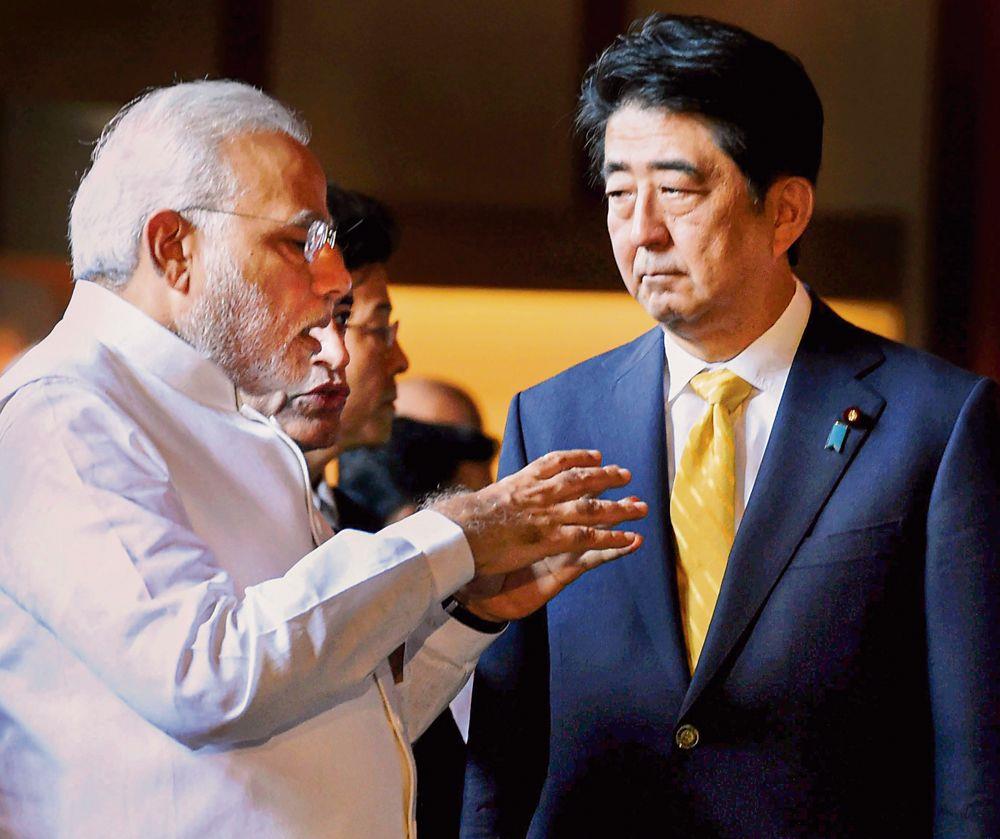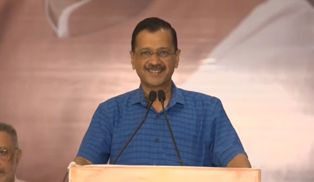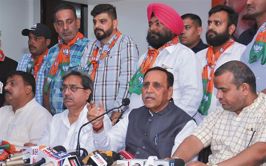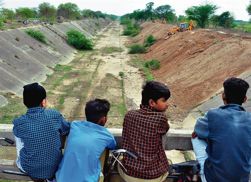
Shared bonds: Shinzo Abe recognised India’s potential as a partner and worked to make the friendship mutually beneficial. PTI
Tarun Das
Former Director General, CII
One of the greatest tragedies of recent times has been the assassination of former Prime Minister of Japan, Shinzo Abe. He was an incredible friend of India and Prime Minister Narendra Modi as well as a visionary for Japan, Asia and the world. Abe served four terms as the Prime Minister of Japan, finally stepping down in 2020. Even afterwards, there were rumours that he was likely to come back again for a fifth term. This was the quality of an extraordinary leader of Japan and indeed a world leader.
First, his friendship with India. He was clear that India had a major role in Asia and the world and unlike several of his predecessors, he saw India as central to peace, balance, development and growth.
Early in his leadership role, he met Modi when the latter was the Chief Minister of Gujarat. They developed a unique personal chemistry and when Modi became the PM in 2014, the friendship flowered, the bilateral relationship deepened and broadened and the period from 2014 to 2020 saw significant diversification of partnership and collaboration, both bilateral and global.
From 2006 onward, India and Japan also started a Track II strategic dialogue, initially Trilateral: USA-Japan-India, later converging into a bilateral India-Japan Strategic Dialogue. From the very beginning of this process, Abe-san met the group, trilateral and bilateral, interacted, listened to suggestions and ideas.
The strategic dialogue raised issues such as Japan becoming stronger in defence capability (not on Japan’s agenda after World War II), maritime cooperation, energy partnership, economic relations, China, etc. Gradually, the approaches of India and Japan converged, thanks to the blessings of Abe-san and the strong leadership on the Japanese side of Kasai-san, Chairman, JR Central (high-speed rail company).
The Centre of Strategic & International Studies (CSIS), a leading think-tank of the USA, and the Ananta Aspen Centre of India partnered to create and sustain this strategic dialogue. The trilateral initiative served to build a bridge between India and Japan but as the mutual understanding grew stronger, the USA discontinued participation and left it to India and Japan to forge ahead together.
Abe-san, in all his meetings with the group, constantly emphasised the importance of peace and stability, the role of USA, Japan and India working together. In one meeting, he raised the question of including Australia.
Abe-san had a crucial role to play in the creation of Quad, the bringing together of four democracies and the steady evolution of trust and partnership in a variety of areas of common interest.
It was fitting that at the Quad summit in Tokyo in May this year, the new initiative of the Indo-Pacific Economic Framework (IPEF) was launched, something very close to his heart and his priorities to see many countries coming together to build closer economic cooperation. IPEF was Abe-san’s dream come true.
During his fourth term as the PM (2017-20), another significant bilateral development took place — unheralded, unpublicised but important. In spite of Japan and India being Asian countries, cultures, practices and customs were very different. Mutual ignorance and lack of awareness about each other was always at a high level. People-to-people connections needed to be built.
With Japan rapidly becoming an ageing society, shortages in the workforce were developing in spite of technology and automation. In this situation, a scheme was launched for Indians to be trained to go and work as interns in Japanese industry. The programme started on a pilot scale with 15 skilled Indian workmen going to Japan to work, after detailed orientation and training.
Another major initiative was in the area of health. India continued to have a significant number of persons suffering from leprosy. One estimate of the number of leprosy colonies in India is 750. Into this situation came Japan with the setting up of the Sasakawa-India Leprosy Foundation (S-ILF) to focus on skill development and livelihood generation for persons from the leprosy colonies.
This initiative which started in 2006, led by Yohei Sasakawa who has dedicated his life to eradicating leprosy, was supported by the Japanese government. Thousands of men, women and children have benefited even though they live in leprosy colonies.
To build understanding between MPs of both countries, and therefore deepen mutual cooperation, the Nippon Foundation and the Ananta Centre came together to organise round tables and exchange of visits by delegations of MPs. Though Covid-19 interrupted the schedule, this is an important programme bridging the gulf between the parliaments of India and Japan. Once again, this was another initiative taken with the blessings of Abe-san.
The India-Japan Strategic Dialogue led to the creation of the India-Japan Forum (IJF) involving both government and non-government participants. The Forum was organised by the Ananta Centre with the support of the Ministry of External Affairs and brought together an equal number of Indians and Japanese — 40 each — to focus on the Indo-Pacific and economic and trade ties. This forum is to be held annually, to review the state of bilateral relations and identify future opportunities. The 2021 IJF was addressed by the Foreign Ministers of both countries and senior representatives of business and industry, think-tanks, senior armed services officers, media and government officials. The discussions follow the ‘Chatham House Rule’.
China figured prominently in all discussions, at every level, and Abe-san worked tirelessly for regional peace, especially in East Asia. He said little in public but his actions reflected priority to build balance. India figured prominently in his strategy, plans and actions. With China becoming more publicly aggressive, and forgetting the advice of Deng Xiaoping to move softly, Abe-san’s work of building a coalition of concerned partners and collaborators actually received a fillip. History will show that whilst Japan, under the leadership of Abe-san, earned steadily rising levels of trust, China on the other hand, rapidly lost the trust of its neighbours and indeed the international community. In his lifetime, cut short tragically, he would have seen the results of his efforts.
India, for example, has continued to engage in dialogue with China, up to now with little or no reciprocity or response. India, too, was initially hesitant about Quad but the actions of China have helped create a clear pathway for India.
In Japan, too, “Abenomics” which was the title given to his economic programme and policies, was designed to strengthen Japan to be more resilient in the face of China’s power and position. Abe-san focused on the economy, deepened the relationship with the USA and reached out strongly to India and Australia too.
Abe-san has left Japan in a better place through his reforms and expansion of “self-defence” forces. He has also left the world of collaboration, between countries, in a better place, e.g. Quad.
In conclusion, it is important to recognise that, since 2014, in PM Modi, he had a strong partner as well as a close friend and they both worked in close harmony on multiple fronts — bilateral and multi-lateral. These have been the finest years of India-Japan partnership led by two strong prime ministers.
Abe-san leaves a huge positive legacy for Japan, for India-Japan cooperation and for a better world order.
Join Whatsapp Channel of The Tribune for latest updates.




























